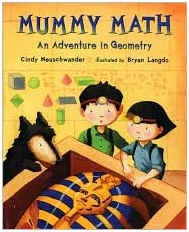Mummy Math

Cindy Neuschwander / Grades 1-4 /
Matt and Bibi go to Egypt with their scientist parents in search of an
ancient pharaoh's mummy. When the siblings are accidentally shut in the
pyramid, they decide to explore. Using hieroglyphic clues, they discover
that the path to the mummy is delineated by "faces," the flat surfaces of
geometric solids. As they find either pictures of solid shapes or the objects
themselves, the twins count the faces of the shapes and are guided through
the pyramid by relating their answers to the hieroglyphic clues. They find
the mummy and a map indicating the way out.
Standards
|
MST
|
Standard 3: Mathematics
3.2 Numbers and Numeration: Students use number sense and numeration to develop an understanding of the multiple uses of numbers in the real world, the use of numbers to communicate mathematically, and the use of numbers in the development of mathematical ideas.
3.3 Operations: Students use mathematical operations and relationships among them to understand mathematics.
3.4 Modeling/Multiple Representation: 4. Students use mathematical modeling/multiple representation to provide a means of presenting, interpreting, communicating, and connecting mathematical information and relationships.
3.7 Patterns and Functions: Students use patterns and functions to develop mathematical power, appreciate the true beauty of mathematics, and construct generalizations that describe patterns simply and efficiently.
|
ELA
|
Standard 1: Language for Information and Understanding
1.1 Listening and Reading: Listening and reading to acquire information and understanding involves collecting data, facts, and ideas; discovering relationships, concepts, and generalizations; and using knowledge from oral, written, and electronic sources.
Standard 2: Language for Literary Response and Expression
2.1 Language for Literary Response and Expression: Listening and reading for literary response involves comprehending, interpreting, and critiquing imaginative texts in every medium, drawing on personal experiences and knowledge to understand the text, and recognizing the social, historical and cultural features of the text.
|
Social Studies
|
Standard 2: World History
2.1.The study of world history requires an understanding of world cultures and civilizations, including an analysis of important ideas, social and cultural values, beliefs, and traditions. This study also examines the human condition and the connections and interactions of people across time and space and the ways different people view the same event or issue from a variety of perspectives.
2.2 Establishing timeframes, exploring different periodizations, examining themes across time and within cultures, and focusing on important turning points in world history help organize the study of world cultures and civilizations.
Standard 3: Geography
3.1 Geography can be divided into six essential elements which can be used to analyze important historic, geographic, economic, and environmental questions and issues. These six elements include: the world in spatial terms, places and regions, physical settings (including natural resources), human systems, environment and society, and the use of geography.
|


